Spatiotemporal Variation of Soil Erosion Characteristics in the Qinghai Lake Basin Based on the InVEST Model
Abstract
1. Introduction
2. Materials and Methods
2.1. Study Area
2.2. Data Sources
2.3. Methods
2.3.1. InVEST Model
2.3.2. Input Parameters for Estimating SE
- (1)
- Rainfall erosion factor (R)
- (2)
- Soil erodibility factor (K)
- (3)
- Slope length and slope factor (LS)
- (4)
- VC and management factors (C)
- (5)
- Soil and water conservation measure factor (P)
2.3.3. Geodetector Analysis
3. Results
3.1. Spatiotemporal Variation Characteristics of SE in the QLB
3.1.1. Temporal Variation Characteristics of SE in the QLB
3.1.2. Spatial Variation Characteristics of SE in the QLB
3.2. Impacts of LU Types on SE in the QLB
3.3. Vertical Differences Analysis of SE in the QLB
3.4. Impacts of Slope on SE in the QLB
4. Factors Influencing SE in the QLB
5. Discussion
6. Conclusions
Author Contributions
Funding
Institutional Review Board Statement
Informed Consent Statement
Data Availability Statement
Acknowledgments
Conflicts of Interest
References
- Xie, G.D.; Zhang, C.X.; Zhang, C.S.; Xiao, Y.; Lu, C.X. The value of ecosystem services in China. Resour. Sci. 2015, 37, 1740–1746. [Google Scholar]
- Zhang, J.; Cao, S.K.; Cao, G.C.; Chen, K.L.; Jiang, G.; Zhang, T.; Han, G.Z.; Lin, Y.Y. Dynamic changes of soil retention in Qinghai Lake Basin. Bull. Soil Water Conserv. 2016, 36, 326–331+350. [Google Scholar]
- Zhao, X.L.; Zhang, Z.X.; Tan, W.B.; Liu, B. Characteristics of soil erosion and its hazard analysis in western China. Bull. Soil Water Conserv. 2002, 22, 15–19. [Google Scholar]
- Zhao, X.Y.; Wang, J.F.; Li, Q.; Li, W.J. Study on soil conservation function in north Three Rivers Basin based on InVEST model. J. Shihezi Univ. Nat. Sci. 2022, 40, 487–496. [Google Scholar]
- Wischmeier, W.H.; Smith, D.D. Predicting Rainfall-Erosion Losses from Cropland East of the Rocky Mountains; U.S. Department of Agriculture: Washington, DC, USA, 1965.
- Wischmeier, W.H.; Smith, D.D. Predicting Rainfall Erosion Losses: A Guide To Conservation Planning; U.S. Department of Agriculture: Washington, DC, USA, 1978.
- Li, J.L.; Sun, R.H.; Xiong, M.Q.; Yang, G.C. Spatiotemporal law of soil water erosion in China based on RUSLE model. Acta Ecol. Sin. 2020, 40, 3473–3485. [Google Scholar]
- Renard, K.G. Predicting Soil Erosion by Water: A Guide to Conservation Planning with the Revised Universal Soil Loss Equation (RUSLE); U.S. Department of Agriculture: Washington, DC, USA, 1997.
- Qin, W.; Guo, Q.; Cao, W.; Yin, Z.; Yan, Q.; Shan, Z.; Zheng, F.A. A new RUSLE slope length factor and its application to soil erosion assessment in a Loess Plateau watershed. Soil Tillage Res. 2018, 182, 10–24. [Google Scholar] [CrossRef]
- Yang, J.; Xie, B.P.; Zhang, D.G.; Chen, J.G. Evaluation of soil erosion in the Yellow River Basin based on InVEST Model and Its temporal and spatial changes. J. Lanzhou Univ. Nat. Sci. 2021, 57, 650–658. [Google Scholar]
- Zhou, B.; Yu, X.X.; Chen, L.H.; Zhang, Z.M.; Lv, X.Z.; Fan, M.R. Simulation of soil erosion in mountainous areas of Beijing based on InVEST Model. Res. Soil Water Conserv. 2010, 17, 9–13+19. [Google Scholar]
- Li, T.; Liu, K.; Hu, S.; Bao, Y.B. Soil loss and soil conservation ecological benefit evaluation of Qinling Mountains based on InVEST Model. Resour. Environ. Yangtze Basin 2014, 23, 1242–1250. [Google Scholar]
- He, S.S.; Ye, L.P.; Zhu, W.B.; Cui, Y.P.; Zhu, L.Q. Study on soil erosion and water supply changes in the Qihe River Basin of Taihang Mountains from 2000 to 2015. Geogr. Res. 2018, 37, 1775–1788. [Google Scholar]
- Zhai, R.J.; Zhao, W.W.; Jia, L.Z. A comparative study on soil erosion estimation based on RUSLE, InVEST, and USPED: A case study of Yanhe River Basin in northern Shanxi. Res. Agric. Mod. 2020, 41, 1059–1068. [Google Scholar]
- Han, J.; Cui, J.F.; Yang, W.; Xu, Y.J.Z.; Qin, D.H.; Gao, F.J. Analysis of soil erosion change and driving factors in a low mountain and hilly area based on InVEST Model. Res. Soil Water Conserv. 2022, 29, 32–39. [Google Scholar]
- Zhang, W.; Wang, F.C.; Wan, H.L.; Zhang, L.J.; Li, Z.M.; Wang, H.X. Spatiotemporal variation of soil conservation services and its influencing factors based on the InVEST model—A case study of Zhang Cheng area, Hebei, the upper reaches of Miyun Reservoir. Prog. Geophys. 2022, 37, 1–13. [Google Scholar]
- Aneseyee, A.B.; Elias, E.; Soromessa, T.; Feyisa, G.L. Land use/land cover change effect on soil erosion and sediment delivery in the Winike watershed, Omo Gibe Basin, Ethiopia. Sci. Total Environ. 2020, 728, 138776. [Google Scholar] [CrossRef]
- Marques, S.M.; Campos, F.S.; David, J.; Cabral, P. Modelling sediment retention services and soil erosion changes in Portugal: A Spatiotemporal approach. ISPRS Int. J. Geo-Inf. 2021, 10, 262. [Google Scholar] [CrossRef]
- Cao, S.C.; Chen, K.L.; Cao, G.C.; Zhu, J.F.; Lu, B.L.; Zhang, T.; Wang, G.M. Distribution characteristics of soil organic carbon density in Kobresia meadows in the Qinghai Lake Basin. Acta Ecol. Sin. 2014, 34, 482–490. [Google Scholar]
- Li, X.Y.; Xu, H.Y.; Ma, Y.J.; Wang, J.H.; Sun, Y.L. Study on land use/cover change in Qinghai Lake Basin. J. Nat. Resour. 2008, 23, 285–296. [Google Scholar]
- Gao, X.H.; Wang, Y.M.; Feng, Y.S.; Wang, J.H.; Ma, A.Q. Research on land use change and its impact on the ecological environment in Qinghai Lake Basin based on Remote Sensing and GIS. Remote Sens. Technol. Appl. 2002, 17, 304–309. [Google Scholar]
- Chen, X.F. Evaluation of Soil Erosion Status in Qinghai Lake Basin Based on USLE Model. Master’s Thesis, Qinghai Normal University, Xining, China, 2021. [Google Scholar]
- Zhao, M.Y.; Zhao, W.W.; An, Y.M.; Jin, T. Evaluation of soil erosion sensitivity in Qinghai Lake Basin. Sci. Soil Water Conserv. 2012, 10, 15–20. [Google Scholar]
- Han, Y.L.; Yu, D.Y.; Chen, K.L.; Yang, H.Z. Spatial distribution characteristics of temperature and precipitation trends in Qinghai Lake Basin from 2000 to 2018. Arid. Land Geogr. 2022, 45, 999–1009. [Google Scholar]
- Tong, B.X.; Li, Z.J.; Yao, C. Estimation of the spatial distribution of parameters of the raster Xin An Jiang model based on SoilGrids. Adv. Water Sci. 2022, 33, 219–226. [Google Scholar]
- Mammadli, N.; Gojamanov, M. High-resolution soil erodibility K-factor estimation using machine learning generated soil dataset and soil pH levels. Geod. Cartogr. 2021, 70, 44–55. [Google Scholar]
- Sourn, T.; Pok, S.; Chou, P.; Nut, N.; Theng, D.; Prasad, P.V.V. Assessment of land use and land cover changes on soil erosion using Remote Sensing, GIS, and RUSLE Model: A case study of Battambang province, Cambodia. Sustainability 2022, 14, 4066. [Google Scholar] [CrossRef]
- Peng, S.; Gang, C.; Cao, Y.; Chen, Y. Assessment of climate change trends over the Loess Plateau in China from 1901 to 2100. Int. J. Climatol. 2018, 38, 2250–2264. [Google Scholar] [CrossRef]
- Ding, Y.; Peng, S. Spatiotemporal trends and attribution of drought across China from 1901–2100. Sustainability 2020, 12, 477. [Google Scholar] [CrossRef]
- Peng, S.; Ding, Y.; Wen, Z.; Chen, Y.; Cao, Y.; Ren, J. Spatiotemporal change and trend analysis of potential evapotranspiration over the Loess Plateau of China during 2011–2100. Agric. For. Meteorol. 2017, 233, 183–194. [Google Scholar] [CrossRef]
- Peng, S.; Ding, D.; Liu, W.; Li, Z. 1 km monthly temperature and precipitation dataset for China from 1901 to 2017. Earth Syst. Sci. Data 2019, 11, 1931–1946. [Google Scholar] [CrossRef]
- Batjes, N.H.; Ribeiro, E.; Oostrum, A.V. Standardised soil profile data to support global mapping and modeling (WoSIS snapshot 2019). Earth Syst. Sci. Data 2020, 12, 299–320. [Google Scholar] [CrossRef]
- Hengl, T.; Mendes de Jesus, J.; Heuvelink, G.; Gonzalez, M.; Kilibarda, M.; Blagotić, A.; Shangguan, W.; Wright, M.; Geng, X.Y.; Bauer, M.B.; et al. SoilGrids250m: Global gridded soil information based on machine learning. PLoS ONE 2017, 12, 1–40. [Google Scholar] [CrossRef]
- Ministry of Water Resources of The People’s Republic of China. SL190-2007; Soil Erosion Classification and Grading Standard. China Water Conservancy, and Hydropower Press: Beijing, China, 2008; pp. 1–26.
- Zhang, W.B.; Fu, J.S. Different types of rainfall data to estimate rainfall erosion force. Resour. Sci. 2003, 25, 35–41. [Google Scholar]
- Williams, J.R.; Arnold, J.G. A system of erosion—Sediment yield models. Soil Technol. 1997, 11, 43–55. [Google Scholar] [CrossRef]
- Liang, Y.; Liu, X.C.; Cao, L.X.; Zheng, F.L.; Zhang, P.C.; Shi, M.H.; Cao, Q.Y.; Yuan, J.Q. Calculation and macroscopic distribution of soil erosion K value in water erosion zone of China. Soil Water Conserv. China 2013, 10, 35–40+79. [Google Scholar]
- Han, Y.L. Impacts of Climate and Landscape Pattern Changes on Ecosystem Services in Qinghai Lake Basin. Ph.D. Thesis, Qinghai Normal University, Xining, China, 2021. [Google Scholar]
- Cai, C.F.; Ding, S.W.; Shi, Z.H.; Huang, L.; Zhang, G.Y. Research on soil erosion in a small watershed using USLE model and GIS IDRISI. J. Soil Water Conserv. 2000, 14, 19–24. [Google Scholar]
- Chen, H.; Ding, W.G.; Zafar, T.B. Evaluation of soil water erosion in Qilian Mountains National Park based on USLE model. Soil Water Conserv. China 2020, 18, 38–44. [Google Scholar]
- Lin, H.L.; Zheng, S.T.; Wang, X.L. Evaluation of soil erosion in alpine grassland of San Jiang Yuan based on RUSLE model. Acta Prataculturae Sin. 2017, 26, 11–22. [Google Scholar]
- Zou, Y.J.; Yan, Q.W.; Tan, X.L.; Wang, J. Assessment of soil erosion and analysis of driving factors in Weibei mining area. Arid. Land Geogr. 2019, 42, 1387–1394. [Google Scholar]
- Wang, J.F.; Li, X.H.; Christakos, G.; Liao, Y.L.; Zhang, T.; Gu, X.; Zheng, X.-Y. Geographical detectors-based health risk assessment and its application in the neural tube defects study of the Heshun Region, China. Int. J. Geogr. Inf. 2010, 24, 107–127. [Google Scholar] [CrossRef]
- 3744Niu, L.N.; Shao, Q.Q.; Liu, G.B.; Tang, Y.Z. Spatiotemporal characteristics and influencing factors of soil erosion in Liupanshui City. J. Geo-Inf. Sci. 2019, 21, 1755–1767. [Google Scholar]
- Wang, J.F.; Xu, C.D. Geographic probes: Principles and prospects. Acta Geogr. Sin. 2017, 72, 116–134. [Google Scholar]
- Wang, H.; Gao, J.B.; Hou, W.J. Quantitative attribution of soil erosion in karst morphological types based on geographic detectors. Acta Geogr. Sin. 2018, 73, 1674–1686. [Google Scholar]
- Li, F.Y.; He, X.W.; Zhou, C.H. Research progress on slope affecting soil erosion. Res. Soil Water Conserv. 2008, 15, 229–231. [Google Scholar]
- Chen, G.C.; Peng, M.; Zhou, L.H.; Ma, S.Z.; Wang, Y.X. The impact of human activities on the ecological environment in Qinghai Lake Basin and its protection countermeasures. Arid. Land Geogr. 1995, 18, 57–62. [Google Scholar]
- Zhang, F.; Jin, Z.D.; Xiao, J.; Gao, Q.; Shi, Y.W. Response of physical erosion rate to climate change in Qinghai Lake Basin. J. Earth Environ. 2016, 7, 590–597. [Google Scholar]
- Jiang, Y.J.; Li, S.J.; Shen, D.F.; Chen, W.; Jin, C.F. Characteristics of climate change and lake environment response on Qinghai-Tibet Plateau in recent 40 years. Geogr. Sci. 2012, 32, 1503–1512. [Google Scholar]
- Zhou, D.; Zhang, J.; Luo, J.; Guo, G.; Li, B.H. Cause analysis of Qinghai Lake water level change and its future trend forecast. Ecol. Environ. Sci. 2021, 30, 1482–1491. [Google Scholar]
- Feng, Z.W.; Feng, Z.Z. Main ecological environmental problems and countermeasures in the Qinghai Lake Basin. Ecol. Environ. Sci. 2004, 13, 467–469. [Google Scholar]
- Zhang, H.Q.; Peng, M.; Wang, B.; Lu, W.Z.; Gao, Y.H.; Du, T.Y. Analysis on the current situation and causes of ecological environment deterioration in Qinghai Lake. J. Qinghai Environ. 2006, 16, 51–56. [Google Scholar]
- Han, Y.L.; Chen, K.L.; Yu, D.Y. Impact of land use change on habitat quality in Qinghai Lake Basin. Ecol. Environ. Sci. 2019, 28, 2035–2044. [Google Scholar]
- Li, L.; Chen, X.G.; Wang, Z.Y.; Xu, W.X.; Tang, H.Y. Research on regional climate change and its differences on the Qinghai-Tibet Plateau. Clim. Chang. Res. 2010, 6, 181–186. [Google Scholar]
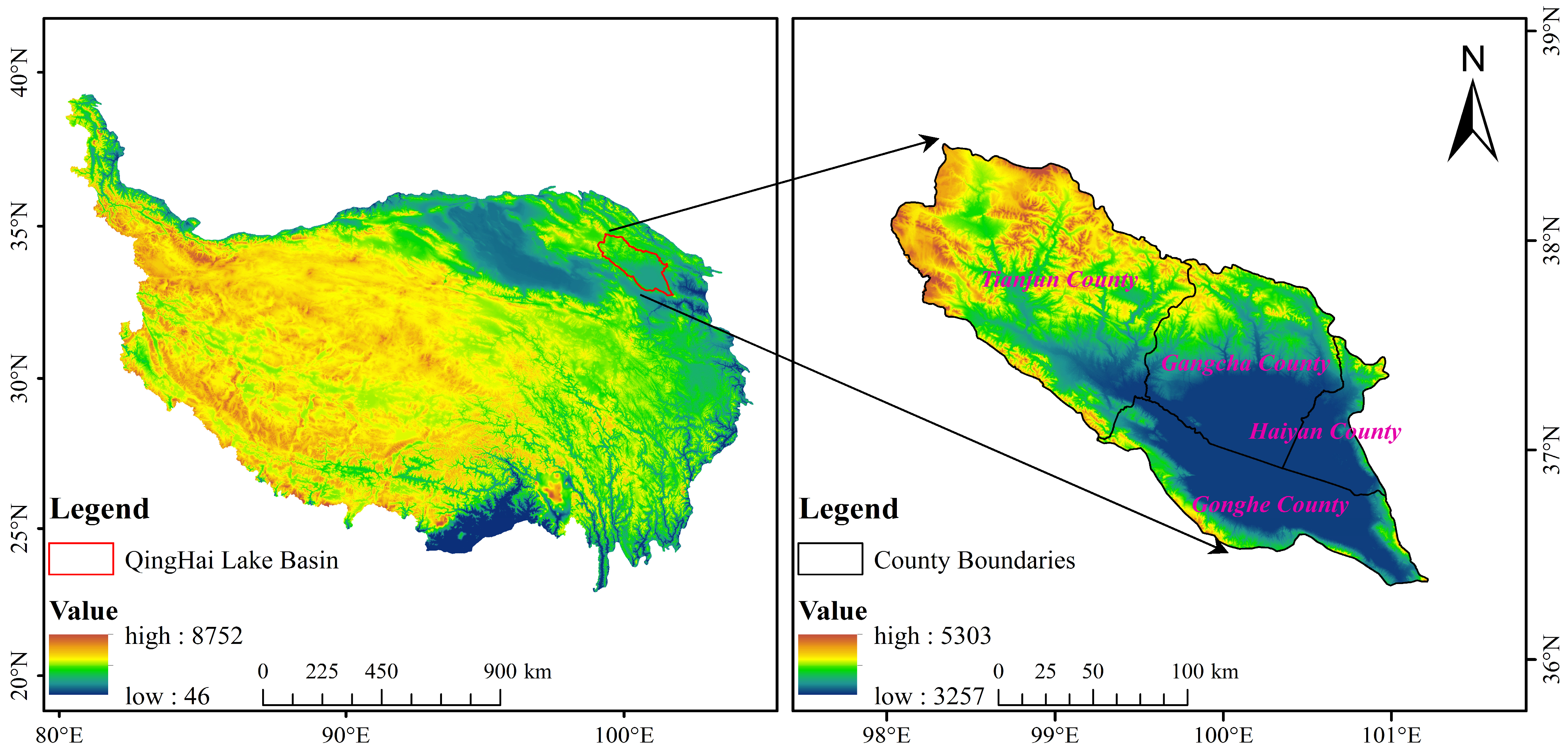
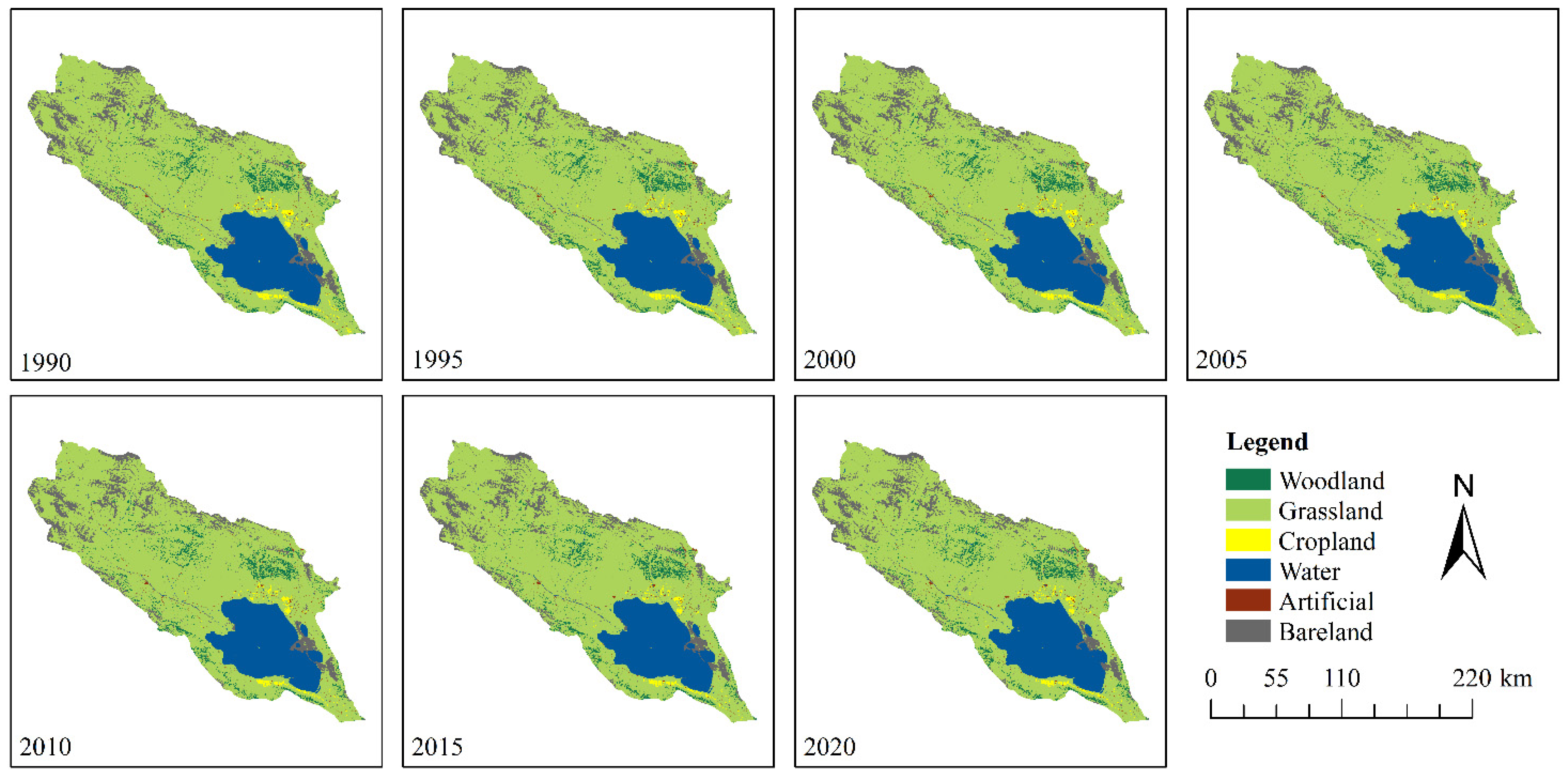
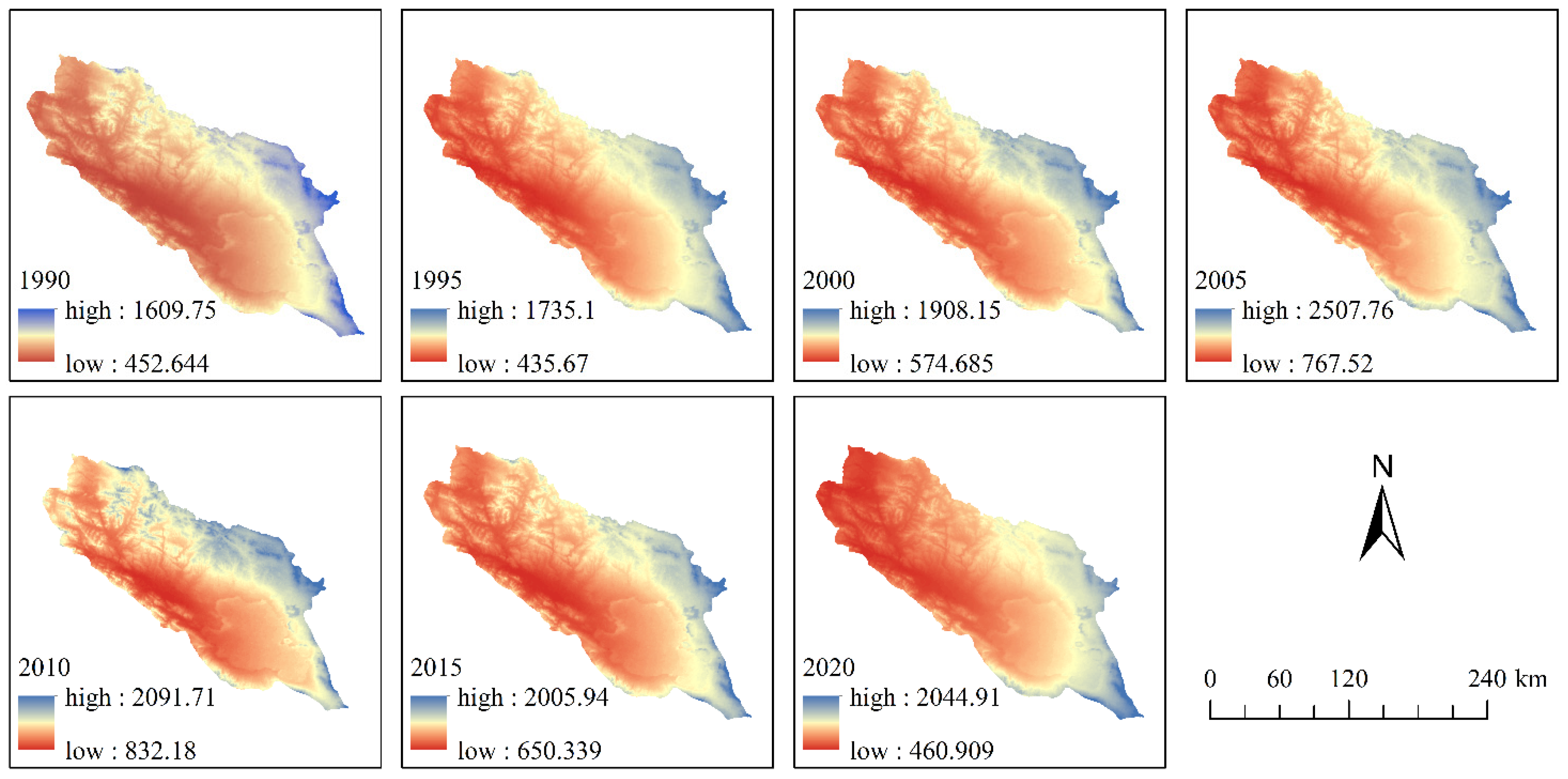
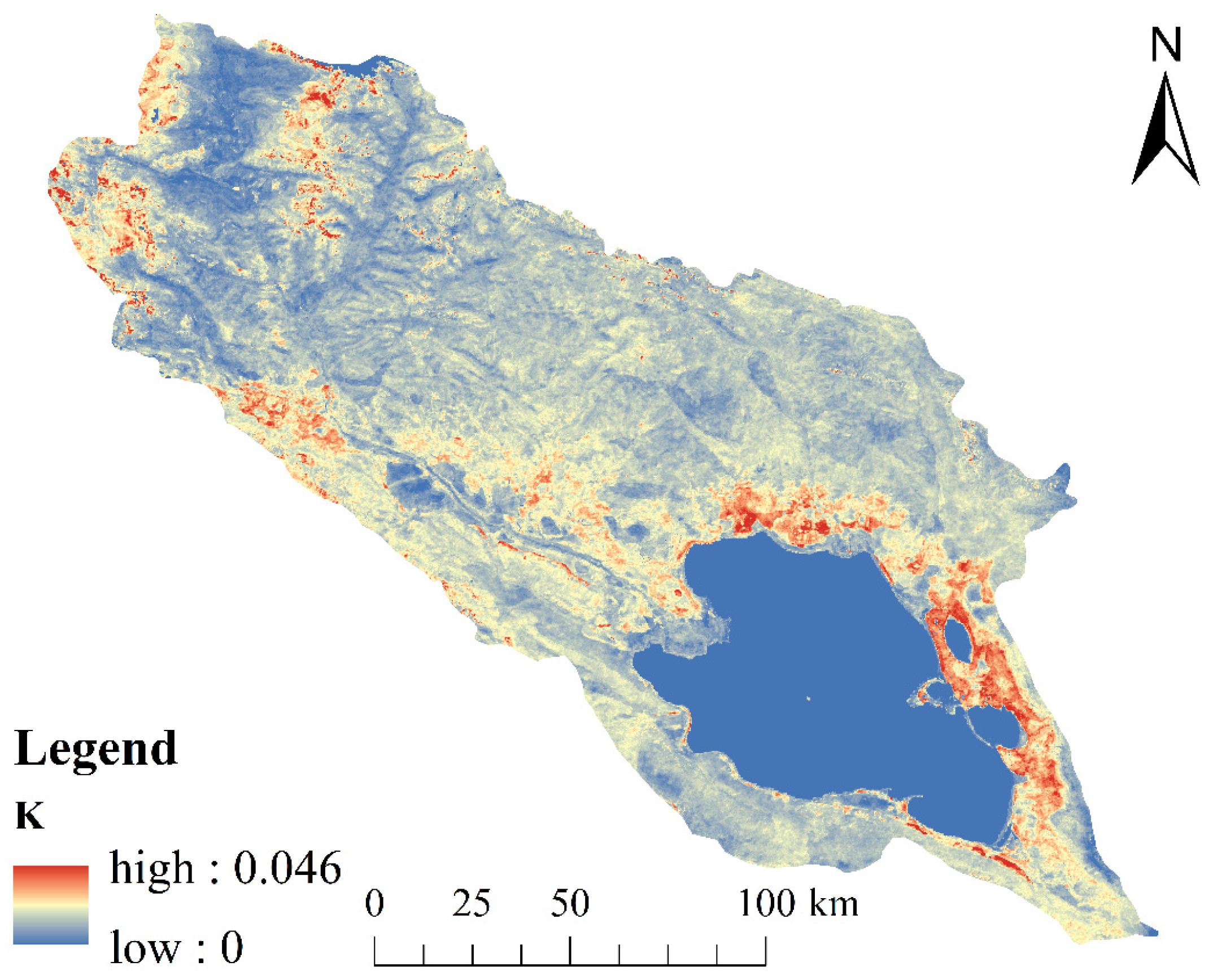

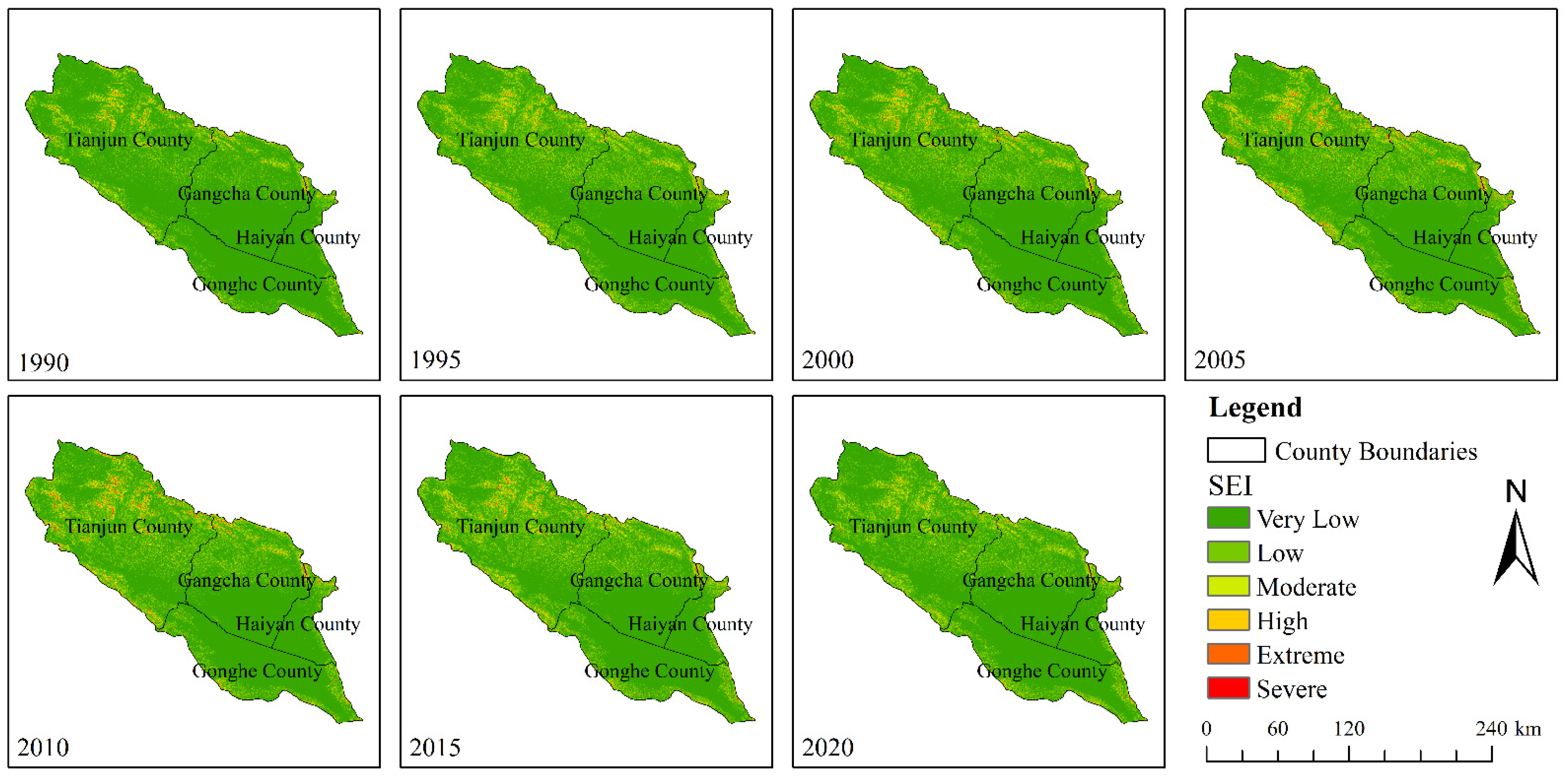
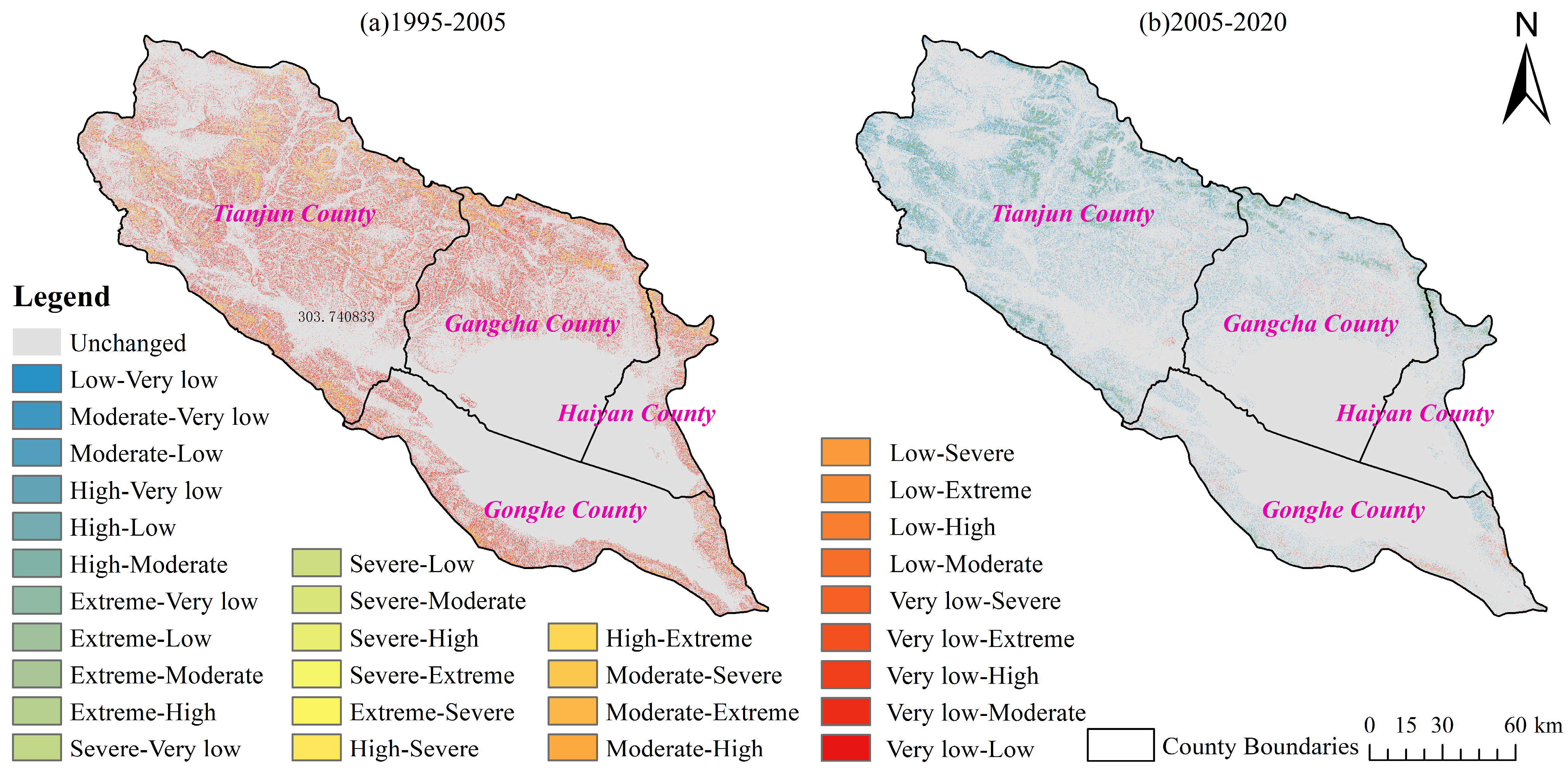
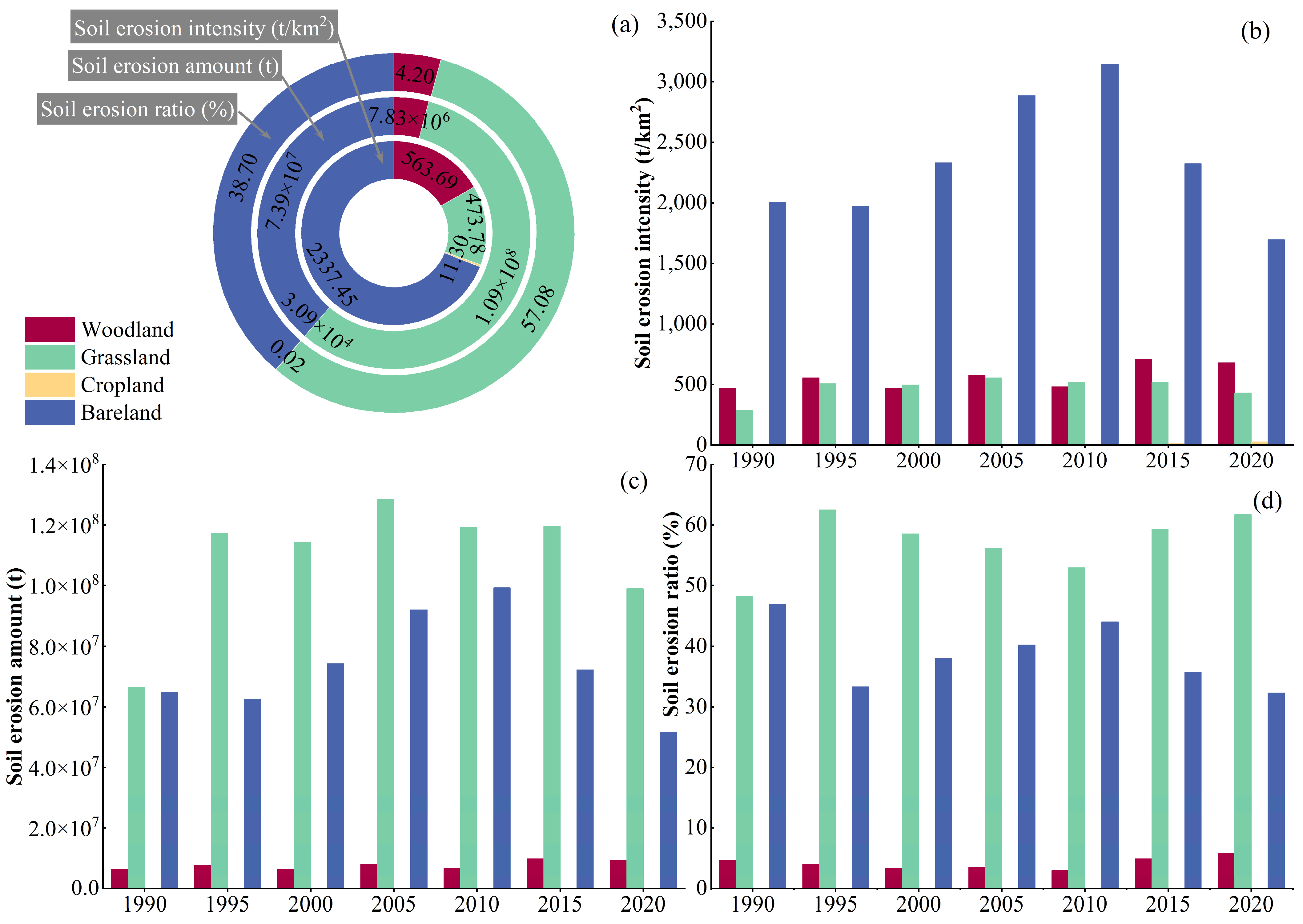
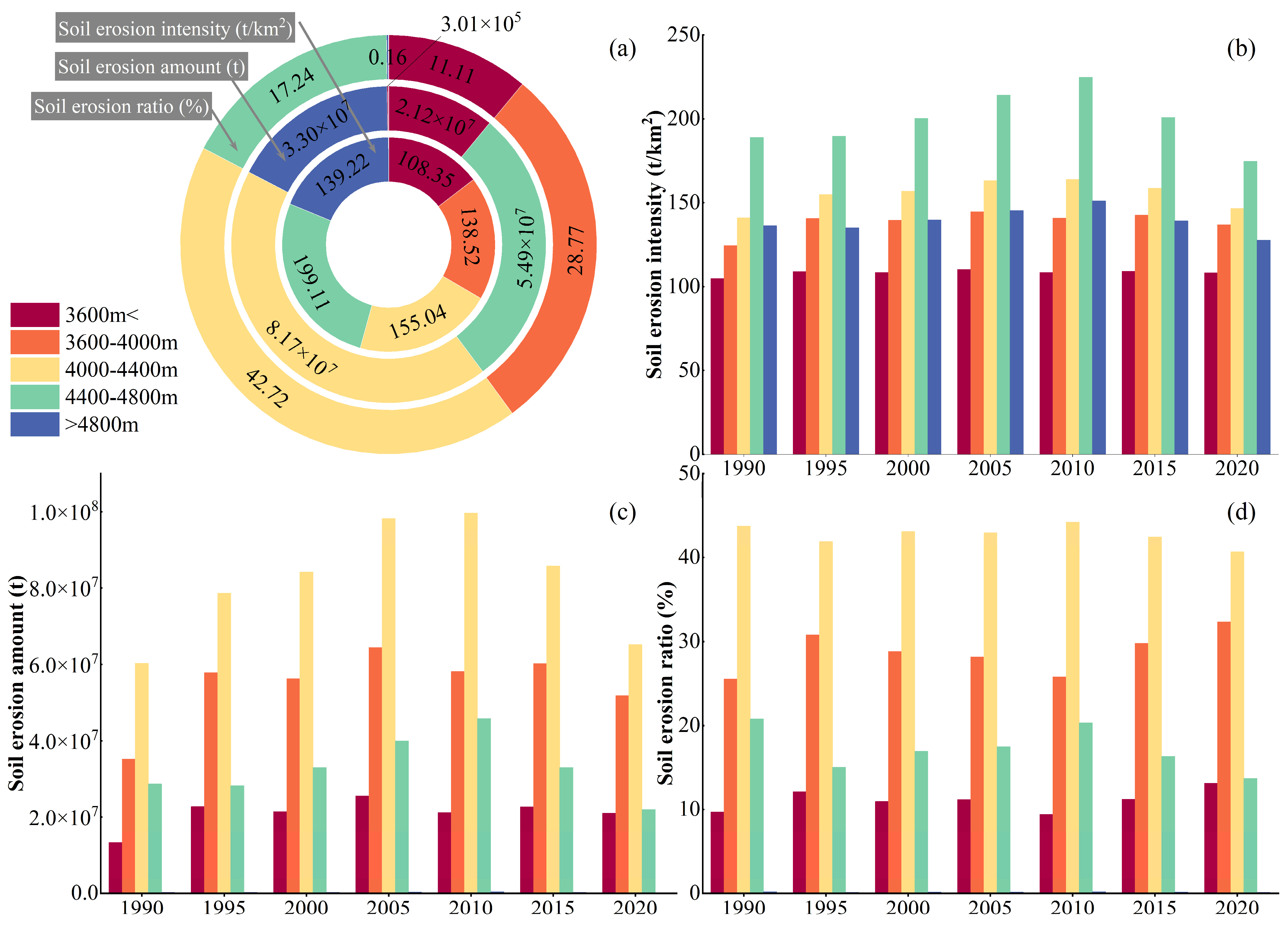

| Data | Date Resource | Resolution | Year | Purpose |
|---|---|---|---|---|
| DEM | Geospatial Data Cloud (https://www.gscloud.cn/ (accessed on 1 June 2022)) | 30 m | 2011 | model LS calculation, extraction of elevation, and slope |
| LULC | United States Geological Survey (https://glovis.usgs.gov (accessed on 1 June 2022)) | 30 m | 1990, 1995, 2000, 2005, 2010, 2015, 2020 | providing the LU type data |
| R [28,29,30,31] | The National Qinghai–Tibet Plateau Scientific Data Center of China (https://data.tpdc.ac.cn (accessed on 1 June 2022)) | 1000 m | 1990, 1995, 2000, 2005, 2010, 2015, 2020 | extracting the mean value of the dataset to generate the mean annual rainfall |
| SoilGrids [32,33] | The International Soil Information Center | 250 m | 2020 | calculating the soil erodibility factor (K) |
| Type | Woodland | Grassland | Cropland | Water | Artificial | Bareland |
|---|---|---|---|---|---|---|
| P | 1 | 1 | 0.4 | 0 | 0 | 1 |
| SEI | Year | SE Area/km2 | SER/% | SEI | Year | SE Area/km2 | SER/% |
|---|---|---|---|---|---|---|---|
| Very Low | 1990 | 24,388.95 | 82.20 | Low | 1990 | 4163.08 | 14.03 |
| 1995 | 22,251.17 | 75.00 | 1995 | 5814.87 | 19.60 | ||
| 2000 | 22,324.74 | 75.24 | 2000 | 5650.18 | 19.04 | ||
| 2005 | 21,697.51 | 73.13 | 2005 | 5957.07 | 20.08 | ||
| 2010 | 21,997.65 | 74.14 | 2010 | 5710.37 | 19.25 | ||
| 2015 | 21,959.54 | 74.01 | 2015 | 5945.40 | 20.04 | ||
| 2020 | 22,937.86 | 77.31 | 2020 | 5454.76 | 18.39 | ||
| Moderate | 1990 | 729.84 | 2.46 | High | 1990 | 246.97 | 0.83 |
| 1995 | 1068.60 | 3.60 | 1995 | 334.88 | 1.13 | ||
| 2000 | 1074.96 | 3.62 | 2000 | 375.68 | 1.27 | ||
| 2005 | 1190.54 | 4.01 | 2005 | 464.87 | 1.57 | ||
| 2010 | 1123.76 | 3.79 | 2010 | 464.21 | 1.56 | ||
| 2015 | 1136.78 | 3.83 | 2015 | 383.22 | 1.29 | ||
| 2020 | 889.98 | 3.00 | 2020 | 251.01 | 0.85 | ||
| Extreme | 1990 | 114.61 | 0.39 | Severe | 1990 | 26.05 | 0.09 |
| 1995 | 161.07 | 0.54 | 1995 | 38.91 | 0.13 | ||
| 2000 | 194.86 | 0.66 | 2000 | 49.07 | 0.17 | ||
| 2005 | 277.22 | 0.93 | 2005 | 82.28 | 0.28 | ||
| 2010 | 286.22 | 0.96 | 2010 | 87.28 | 0.29 | ||
| 2015 | 195.37 | 0.66 | 2015 | 49.19 | 0.17 | ||
| 2020 | 111.31 | 0.38 | 2020 | 24.57 | 0.08 |
| 1990–2005 | Very low | Low | Moderate | High | Extreme | Severe |
|---|---|---|---|---|---|---|
| Very low | 73.11 | 9.08 | 0.00 | - | - | - |
| Low | 0.02 | 10.99 | 2.99 | 0.03 | 0.01 | 0.00 |
| Moderate | 0.00 | 0.01 | 1.02 | 1.31 | 0.13 | 0.00 |
| High | 0.00 | 0.00 | 0.00 | 0.23 | 0.59 | 0.01 |
| Extreme | 0.00 | 0.00 | 0.00 | 0.00 | 0.21 | 0.18 |
| Severe | - | - | 0.00 | 0.00 | 0.00 | 0.09 |
| 2005–2020 | Very low | Low | Moderate | High | Extreme | Severe |
|---|---|---|---|---|---|---|
| Very low | 72.92 | 0.21 | 0.00 | 0.00 | 0.00 | - |
| Low | 4.39 | 15.63 | 0.05 | 0.00 | 0.00 | - |
| Moderate | 0.00 | 2.53 | 1.46 | 0.02 | 0.00 | 0.00 |
| High | 0.00 | 0.00 | 1.32 | 0.23 | 0.01 | 0.00 |
| Extreme | 0.00 | 0.00 | 0.17 | 0.59 | 0.17 | 0.00 |
| Severe | 0.00 | - | 0.00 | 0.00 | 0.19 | 0.08 |
| Index | LULC | Multi-Year Average | 1990 | 1995 | 2000 | 2005 | 2010 | 2015 | 2020 |
|---|---|---|---|---|---|---|---|---|---|
| SEI (t/km2) | Woodland | 563.69 | 469.86 | 554.08 | 469.18 | 579.34 | 482.32 | 711.73 | 679.31 |
| Grassland | 473.78 | 289.23 | 508.43 | 495.87 | 556.24 | 515.74 | 519.11 | 431.87 | |
| Cropland | 11.30 | 8.98 | 8.30 | 6.96 | 8.11 | 5.70 | 14.71 | 26.34 | |
| Bare land | 2337.45 | 2005.74 | 1975.00 | 2332.13 | 2887.17 | 3143.45 | 2322.53 | 1696.16 | |
| SEA (t) | Woodland | 7.83 × 106 | 6.51 × 106 | 7.68 × 106 | 6.51 × 106 | 8.05 × 106 | 6.72 × 106 | 9.91 × 106 | 9.46 × 106 |
| Grassland | 1.09 × 108 | 6.66 × 107 | 1.17 × 108 | 1.14 × 108 | 1.29 × 108 | 1.19 × 108 | 1.20 × 108 | 9.90 × 107 | |
| Cropland | 3.09 × 104 | 2.79 × 104 | 2.58 × 104 | 2.22 × 104 | 2.20 × 104 | 1.42 × 104 | 3.68 × 104 | 6.77 × 104 | |
| Bare land | 7.39 × 107 | 6.48 × 107 | 6.26 × 107 | 7.44 × 107 | 9.20 × 107 | 9.93 × 107 | 7.24 × 107 | 5.18 × 107 | |
| SER (%) | Woodland | 4.20 | 4.72 | 4.10 | 3.33 | 3.52 | 2.98 | 4.91 | 5.90 |
| Grassland | 57.08 | 48.28 | 62.53 | 58.58 | 56.22 | 52.93 | 59.26 | 61.74 | |
| Cropland | 0.02 | 0.02 | 0.01 | 0.01 | 0.01 | 0.01 | 0.02 | 0.04 | |
| Bare land | 38.70 | 46.98 | 33.37 | 38.08 | 40.25 | 44.08 | 35.81 | 32.31 |
| Index | Dem (m) | Multi-Year Average | 1990 | 1995 | 2000 | 2005 | 2010 | 2015 | 2020 |
|---|---|---|---|---|---|---|---|---|---|
| SEI (t/km2) | 3600 m< | 147.76 | 93.43 | 158.85 | 149.70 | 178.67 | 148.23 | 158.44 | 147.03 |
| 3600–4000 m | 633.11 | 406.79 | 666.98 | 649.49 | 743.87 | 671.16 | 695.18 | 598.29 | |
| 4000–4400 m | 992.33 | 733.09 | 954.45 | 1022.35 | 1192.40 | 1210.80 | 1041.18 | 792.02 | |
| 4400–4800 m | 1940.66 | 1686.74 | 1661.05 | 1945.05 | 2355.97 | 2696.12 | 1945.13 | 1294.60 | |
| >4800 m | 708.26 | 633.25 | 606.80 | 709.40 | 852.43 | 1016.95 | 699.91 | 439.07 | |
| SEA (t) | 3600 m< | 2.12 × 107 | 1.34 × 107 | 2.27 × 107 | 2.14 × 107 | 2.56 × 107 | 2.12 × 107 | 2.27 × 107 | 2.11 × 107 |
| 3600–4000 m | 5.49 × 107 | 3.53 × 107 | 5.78 × 107 | 5.63 × 107 | 6.45 × 107 | 5.82 × 107 | 6.03 × 107 | 5.19 × 107 | |
| 4000–4400 m | 8.17 × 107 | 6.04 × 107 | 7.86 × 107 | 8.42 × 107 | 9.82 × 107 | 9.97 × 107 | 8.57 × 107 | 6.52 × 107 | |
| 4400–4800 m | 3.30 × 107 | 2.87 × 107 | 2.82 × 107 | 3.31 × 107 | 4.00 × 107 | 4.58 × 107 | 3.31 × 107 | 2.20 × 107 | |
| >4800 m | 3.01 × 105 | 2.69 × 105 | 2.58 × 105 | 3.02 × 105 | 3.62 × 105 | 4.32 × 105 | 2.98 × 105 | 1.87 × 105 | |
| SER (%) | 3600 m< | 11.11 | 9.70 | 12.12 | 10.98 | 11.19 | 9.42 | 11.23 | 13.13 |
| 3600–4000 m | 28.77 | 25.56 | 30.81 | 28.83 | 28.20 | 25.82 | 29.83 | 32.35 | |
| 4000–4400 m | 42.72 | 43.76 | 41.89 | 43.11 | 42.94 | 44.24 | 42.44 | 40.68 | |
| 4400–4800 m | 17.24 | 20.78 | 15.04 | 16.93 | 17.51 | 20.33 | 16.36 | 13.72 | |
| >4800 m | 0.16 | 0.20 | 0.14 | 0.15 | 0.16 | 0.19 | 0.15 | 0.12 |
| Index | Slope | Multi-Year Average | 1990 | 1995 | 2000 | 2005 | 2010 | 2015 | 2020 |
|---|---|---|---|---|---|---|---|---|---|
| SEI (t/km2) | <5° | 29.99 | 19.54 | 31.28 | 31.01 | 35.55 | 33.43 | 32.42 | 26.71 |
| 5–8° | 233.04 | 152.62 | 242.27 | 241.03 | 275.69 | 261.00 | 252.01 | 206.67 | |
| 8–15° | 594.93 | 398.04 | 610.79 | 613.44 | 703.77 | 674.17 | 642.02 | 522.30 | |
| 15–25° | 1279.46 | 905.75 | 1272.24 | 1309.21 | 1522.57 | 1492.60 | 1364.59 | 1089.28 | |
| 25–35° | 2246.32 | 1728.12 | 2118.87 | 2279.43 | 2715.06 | 2743.61 | 2332.50 | 1806.65 | |
| >35° | 3356.68 | 2731.46 | 3030.00 | 3390.02 | 4129.40 | 4238.33 | 3398.84 | 2578.75 | |
| SE (t) | <5° | 4.20 × 106 | 2.74 × 106 | 4.38 × 106 | 4.3 × 106 | 4.98 × 106 | 4.69 × 106 | 4.54 × 106 | 3.74 × 106 |
| 5–8° | 8.88 × 106 | 5.82 × 106 | 9.23 × 106 | 9.19 × 106 | 1.05 × 107 | 9.95 × 106 | 9.61 × 106 | 7.88 × 106 | |
| 8–15° | 4.22 × 107 | 2.82 × 107 | 4.33 × 107 | 4.35 × 107 | 4.99 × 107 | 4.78 × 107 | 4.56 × 107 | 3.71 × 107 | |
| 15–25° | 6.85 × 107 | 4.85 × 107 | 6.82 × 107 | 7.01 × 107 | 8.16 × 107 | 8.00 × 107 | 7.31 × 107 | 5.84 × 107 | |
| 25–35° | 4.63 × 107 | 3.56 × 107 | 4.37 × 107 | 4.70 × 107 | 5.60 × 107 | 5.66 × 107 | 4.81 × 107 | 3.72 × 107 | |
| >35° | 2.09 × 107 | 1.70 × 107 | 1.89 × 107 | 2.11 × 107 | 2.57 × 107 | 2.64 × 107 | 2.11 × 107 | 1.60 × 107 | |
| SER (%) | <5° | 2.20 | 1.99 | 2.34 | 2.23 | 2.18 | 2.08 | 2.25 | 2.33 |
| 5–8° | 4.65 | 4.22 | 4.92 | 4.70 | 4.60 | 4.41 | 4.75 | 4.91 | |
| 8–15° | 22.09 | 20.48 | 23.10 | 22.29 | 21.84 | 21.23 | 22.55 | 23.12 | |
| 15–25° | 35.87 | 35.18 | 36.32 | 35.92 | 35.67 | 35.48 | 36.18 | 36.40 | |
| 25–35° | 24.25 | 25.82 | 23.27 | 24.06 | 24.47 | 25.09 | 23.80 | 23.23 | |
| >35° | 10.94 | 12.32 | 10.05 | 10.80 | 11.24 | 11.70 | 10.47 | 10.01 |
| Variable | q | |
|---|---|---|
| 1 | Slope | 0.3298 |
| 2 | LULC | 0.1399 |
| 3 | DEM | 0.0995 |
| 4 | C | 0.0756 |
| 5 | R | 0.0499 |
| R | C | LULC | Dem | Slope | |
|---|---|---|---|---|---|
| R | 0.0499 | 0.1393 | 0.1924 | 0.1721 | 0.3770 |
| C | 0.1393 | 0.0756 | 0.1459 | 0.1461 | 0.3833 |
| LULC | 0.1924 | 0.1459 | 0.1399 | 0.2178 | 0.4370 |
| DEM | 0.1721 | 0.1461 | 0.2178 | 0.0995 | 0.3666 |
| Slope | 0.3770 | 0.3833 | 0.4370 | 0.3666 | 0.3298 |
| Impact Factor | R | C | LULC | Dem | Slope |
|---|---|---|---|---|---|
| High-risk areas | 1220–2510 mm | <0.104 | Bareland | 4400–4800 | >35° |
| Mean SEI | 218.78 | 194.30 | 213.52 | 200.34 | 278.28 |
Disclaimer/Publisher’s Note: The statements, opinions and data contained in all publications are solely those of the individual author(s) and contributor(s) and not of MDPI and/or the editor(s). MDPI and/or the editor(s) disclaim responsibility for any injury to people or property resulting from any ideas, methods, instructions or products referred to in the content. |
© 2023 by the authors. Licensee MDPI, Basel, Switzerland. This article is an open access article distributed under the terms and conditions of the Creative Commons Attribution (CC BY) license (https://creativecommons.org/licenses/by/4.0/).
Share and Cite
Chen, Z.; Gao, X.; Liu, Z.; Chen, K. Spatiotemporal Variation of Soil Erosion Characteristics in the Qinghai Lake Basin Based on the InVEST Model. Int. J. Environ. Res. Public Health 2023, 20, 4728. https://doi.org/10.3390/ijerph20064728
Chen Z, Gao X, Liu Z, Chen K. Spatiotemporal Variation of Soil Erosion Characteristics in the Qinghai Lake Basin Based on the InVEST Model. International Journal of Environmental Research and Public Health. 2023; 20(6):4728. https://doi.org/10.3390/ijerph20064728
Chicago/Turabian StyleChen, Zhen, Xiaohong Gao, Zhifeng Liu, and Kelong Chen. 2023. "Spatiotemporal Variation of Soil Erosion Characteristics in the Qinghai Lake Basin Based on the InVEST Model" International Journal of Environmental Research and Public Health 20, no. 6: 4728. https://doi.org/10.3390/ijerph20064728
APA StyleChen, Z., Gao, X., Liu, Z., & Chen, K. (2023). Spatiotemporal Variation of Soil Erosion Characteristics in the Qinghai Lake Basin Based on the InVEST Model. International Journal of Environmental Research and Public Health, 20(6), 4728. https://doi.org/10.3390/ijerph20064728







